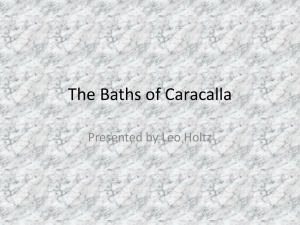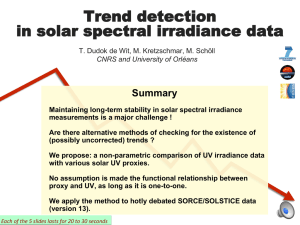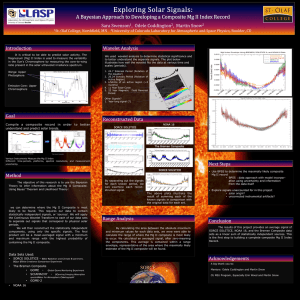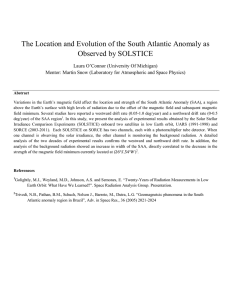SNS • SORCE News Source SORCE’s 9 Birthday!
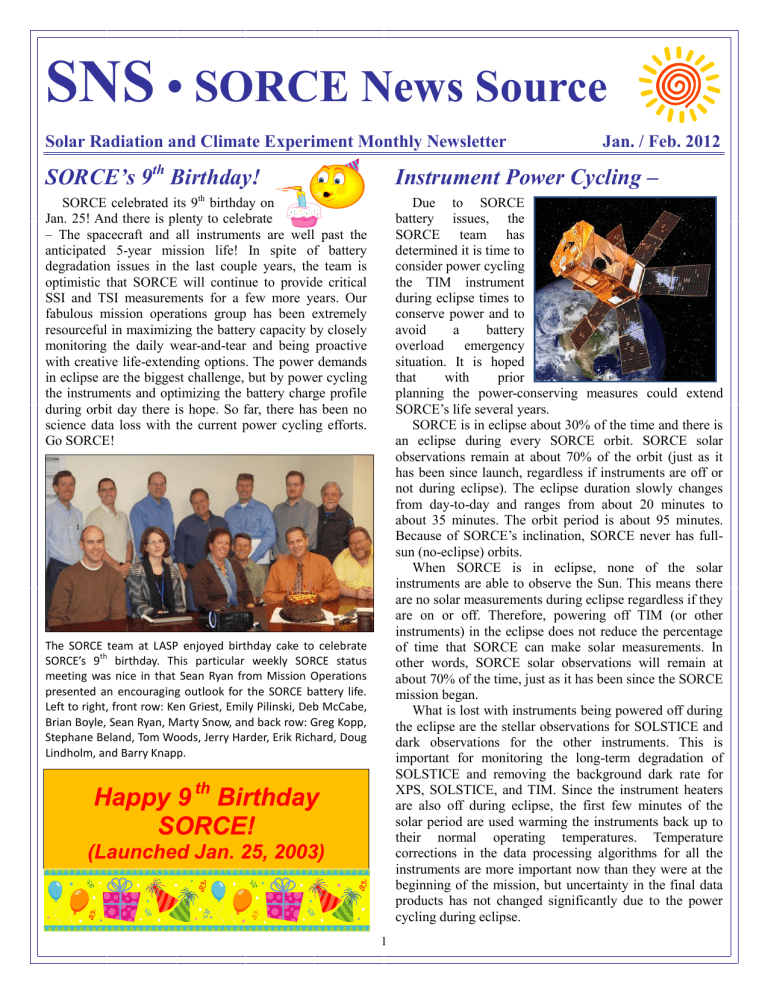
SNS
• SORCE News Source
Solar Radiation and Climate Experiment Monthly Newsletter Jan. / Feb. 2012
SORCE’s 9
th
Birthday!
SORCE celebrated its 9 th
birthday on
Jan. 25! And there is plenty to celebrate
– The spacecraft and all instruments are well past the anticipated 5-year mission life! In spite of battery degradation issues in the last couple years, the team is optimistic that SORCE will continue to provide critical
SSI and TSI measurements for a few more years. Our fabulous mission operations group has been extremely resourceful in maximizing the battery capacity by closely monitoring the daily wear-and-tear and being proactive with creative life-extending options. The power demands in eclipse are the biggest challenge, but by power cycling the instruments and optimizing the battery charge profile during orbit day there is hope. So far, there has been no science data loss with the current power cycling efforts.
Go SORCE!
The SORCE team at LASP enjoyed birthday cake to celebrate
SORCE’s 9 th
birthday. This particular weekly SORCE status meeting was nice in that Sean Ryan from Mission Operations presented an encouraging outlook for the SORCE battery life.
Left to right, front row: Ken Griest, Emily Pilinski, Deb McCabe,
Brian Boyle, Sean Ryan, Marty Snow, and back row: Greg Kopp,
Stephane Beland, Tom Woods, Jerry Harder, Erik Richard, Doug
Lindholm, and Barry Knapp.
Happy 9
th
Birthday
SORCE!
(Launched Jan. 25, 2003)
Instrument Power Cycling –
Due to SORCE battery issues, the
SORCE team has determined it is time to consider power cycling the TIM instrument during eclipse times to conserve power and to avoid a battery overload emergency situation. It is hoped that with prior planning the power-conserving measures could extend
SORCE’s life several years.
SORCE is in eclipse about 30% of the time and there is an eclipse during every SORCE orbit. SORCE solar observations remain at about 70% of the orbit (just as it has been since launch, regardless if instruments are off or not during eclipse). The eclipse duration slowly changes from day-to-day and ranges from about 20 minutes to about 35 minutes. The orbit period is about 95 minutes.
Because of SORCE’s inclination, SORCE never has fullsun (no-eclipse) orbits.
When SORCE is in eclipse, none of the solar instruments are able to observe the Sun. This means there are no solar measurements during eclipse regardless if they are on or off. Therefore, powering off TIM (or other instruments) in the eclipse does not reduce the percentage of time that SORCE can make solar measurements. In other words, SORCE solar observations will remain at about 70% of the time, just as it has been since the SORCE mission began.
What is lost with instruments being powered off during the eclipse are the stellar observations for SOLSTICE and dark observations for the other instruments. This is important for monitoring the long-term degradation of
SOLSTICE and removing the background dark rate for
XPS, SOLSTICE, and TIM. Since the instrument heaters are also off during eclipse, the first few minutes of the solar period are used warming the instruments back up to their normal operating temperatures. Temperature corrections in the data processing algorithms for all the instruments are more important now than they were at the beginning of the mission, but uncertainty in the final data products has not changed significantly due to the power cycling during eclipse.
1
Currently, all instruments except TIM are power cycling to reduce the load on the battery. SOLSTICE A and XPS began power cycling in December 2009.
SOLSTICE B has been turned off during any eclipse longer than 30 minutes since July 2010. Starting in
January 2011, SIM B was also off during eclipse. SIM A also began power cycling in May 2011. SOLSTICE B has transitioned to power cycling for all eclipses in June
2011.
Our latest test of power cycling TIM was not as successful as hoped. Unlike the other instruments, TIM can only operate at peak efficiency over a small range of temperatures, and its heater was unable to warm the heat sink back to normal temperatures when TIM was turned off during the eclipse portion of the orbit. Other options for operating TIM will continue to be explored, but in the current plan, TIM will operate as it has since the beginning of the mission: powered on throughout eclipse.
In the meantime the SORCE team closely monitors the battery status and is diligently managing the charge load during eclipse periods in order to maximize the science and still remain above the minimum operational end-ofeclipse discharge voltage. The operations team has taken numerous steps over the past three years to limit the wear and tear on the battery in order to extend its life. These steps have focused on reducing the power consumed in eclipse and optimizing the battery charge profile during orbit day. We have added a battery expert, Emily Pilinski, to the SORCE team and managing the battery life is one of our top priorities.
The SORCE mission continues to collect science data and all of the instruments are functioning properly.
3 , , , 5 0 4 , , , 3 1 1
Hits to the SORCE Website
(Since 4/21/03, As of 01/27/12)
New Mission Ops Member –
By Sean Ryan, LASP, Univ. of Colorado
In mid December the SORCE mission operations team added a new member – Emily Pilinski. Emily was working for LASP as a student, but recently graduated from CU-Boulder with a Masters in Aerospace
Engineering. Good news for SORCE – she will continue her work with Sean Ryan in LASP’s Mission Operations and Data Systems Division as a Satellite Systems
Engineer/Operator. Prior to joining LASP, Emily worked at JPL pointing the Cassini spacecraft, and at BioServe
Space Technologies developing biological payloads for the
Shuttle and ISS. One of Emily’s tasks will be to focus on the short and long term maintenance of the SORCE battery, as well as to study the battery trends.
2
Some of the SORCE Mission Operations team, left to right: Deb
McCabe, Ken Griest, Emily Pilinski, and Sean Ryan.
SOLSTICE into Version 11 –
By Marty Snow, LASP, Univ. of Colorado
The MUV degradation correction (180-310 nm) has been significantly improved. In this version, the weekly alignment measurements have been used at eight wavelengths to measure the degradation of the optics as a function of field-of-view (FOV) angle. In previous versions, only four wavelengths were used. The algorithm for calculating this FOV correction was revised and produces a much better statistical uncertainty in each week’s measurement. The MUV degradation correction uses the stellar calibration data, the new FOV correction, plus the calibration transfer from the redundant SOLSTICE B instrument. An error in the version 10 degradation correction in the A/B transfer is now believed to have produced the unusually large variation at some wavelengths in the MUV data. The FOV correction in the 180-190 nm range is still preliminary. The correction factor for this wavelength range is currently extrapolated based on longer wavelength trends in the FOV measurement, but analysis of the alignment data from the FUV channel in the wavelength overlap region will reduce the uncertainty of this correction for the next data version. The FUV degradation correction extends the stellar calibration observations to the current epoch but no changes in the FUV algorithm have been implemented version 11. The overall uncertainty in the
SOLSTICE degradation correction is still meeting the 0.5% per year requirement.
Plans for SOLSTICE Version 12:
Improve algorithm for determining A/B transfer.
Improve FOV correction in wavelength range where
FUV and MUV channels overlap (170-190 nm).
The improved degradation correction is particularly important in the middle of the MUV channel for SOLSTICE. Here is a typical wavelength (260.5) showing the old version (black) and the new version (red). The previous version underestimated the amount of degradation in the instrument. Improved analysis of the weekly field-of-view measurements has produced a better measurement of solar variability for
SOLSTICE.
Cross-Calibration using
SOLSTICE Stars –
By Marty Snow, LASP, Univ. of Colorado
SOLSTICE is unique among stellar-observing ultraviolet instruments in that it was accurately calibrated using a NIST standard source (the SURF-III synchrotron).
SORCE scientists have been working with scientists from the Laboratoire Atmospheres, Milieux, Observations
Spatiales (LATMOS) on transferring the SOLSTICE calibration to the stellar occultation instruments on Mars
Express and Venus Express. As a result of using the
SOLSTICE stellar spectra as a reference, we are now able to publish accurate stellar fluxes for over 140 stars observed by the Spectroscopy for Investigation
Characteristics of the Atmosphere of Mars (SPICAM). Our work has also validated the white dwarf flux scale used by the International Ultraviolet Explorer (IUE) and instruments on the Hubble Space Telescope. These results will be published in “Cross-Calibration of Past and Present
Far UV Spectra of Solar System Objects and the
Heliosphere,” Scientific Report #12 from the International
Space Science Institute (R.M. Bonnet, E. Quémerais, and
M. Snow, eds.) later this year.
Workshop: The faint Early Sun:
Problem, paradox, or distraction?
By: David Soderblom, Space Telescope Science Institute
A workshop on this topic will be held at the Space Telescope Science Institute
(STScI) in Baltimore Maryland, April 9-
10, 2012. For details on the science motivation and speaker list for this workshop, please visit their website: http://www.stsci.edu/institute/conference/faint-sun.
The purpose of the workshop is to bring together scientists from a number of disciplines to discuss the state of knowledge of the young Sun and the young solar system. Leading experts from geochemistry, geophysics, planetary science, solar physics, and stellar astronomy will address many related topics. In addition to the invited speakers, contributed talks and posters are welcome and encouraged. Registration and Abstract Deadline: March
15, 2012. For questions, please contact David Soderblom at drs@stsci.edu.
3
Left to right: Greg Holsclaw (LASP), Marty Snow (LASP), Eric
Quémerais (LATMOS-CNRS, Service d’Aéronomie, France), Bill
McClintock (LASP), and Aurélie Reberac (LATMOS-CNRS).
AAAS Meeting, Vancouver –
SORCE PI Tom Woods was invited to the 2012
American Association for the Advancement of Science
(AAAS) Annual Meeting, held Feb. 15-20, in Vancouver,
BC, Canada. This year’s meeting focused on climate change, energy, agriculture, health, water, biodiversity and ecosystems, population growth, and economic development – all current issues that are both global in their scope and profoundly interconnected. This meeting will attempt to develop truly global models, and then
global solutions, through international collaborative efforts making efficient use of the power of modern electronic communications and the information / educational resources available to everyone.
Tom participated in a special session called “Solar
Effects on Earth’s Atmosphere and Climate: Results from
Space Observatories,” and gave an invited talk on
Variability of the Solar Spectral Irradiance and its
Energy Input to Earth's Atmosphere.
His talk focused on how the solar UV radiation could have a top-down influence on climate change through the UV radiation first being deposited into Earth’s stratosphere and then slowly propagating down to the troposphere. Recent studies and modeling efforts indicate that this top-down mechanism is indeed one of the ways that the solar variability can influence climate, including affecting the
El Niño Southern Oscillation (ENSO) that is a dominant source of inter-annual climate variability around the world. Others who gave talks in this Session chaired by
Nancy Morrison (Univ. of Toledo) included Rock Bush
(Stanford Univ.; Solar Magnetism, Solar Activity, and
Variability in Sunlight ) and Georg Feulner (Potsdam-
Institut für Klimafolgenforschung, Germany; What Does the State of Earth's Whole Atmosphere Tell Us About
Climate Change?
).
4
Upcoming Meetings / Talks –
SORCE scientists plan to present papers or attend the following 2012 meetings/workshops:
AAAS Annual Meeting, Feb. 16-20, Vancouver, Canada
Solar Spectral Irradiance (SSI) Variations Workshop,
Feb. 28-March 1, NIST, Gaithersburg, Maryland
ISSI Working Group – An Assessment of the Accuracies and Uncertainties in the TSI Climate Data Record,
March 6-8, Bern Switzerland
Boulder Solar Day, March 20, Boulder, Colorado
Comet Lovejoy Workshop, March 21-22, Boulder,
Colorado
EGU 2012 General Assembly, April 22-27, Vienna,
Austria
On-Orbit Degradation of Solar and Space Weather
Instruments Workshop, May 3-4, Brussels, Belgium
Intl. Radiation Symposium (IRS2012), Aug. 6-10,
Berlin, Germany

